How to set yourself up for a successful game localization project
Getting ready to localize your game? Learn what to consider before starting a localization project, from setting up your file to creating a style guide.
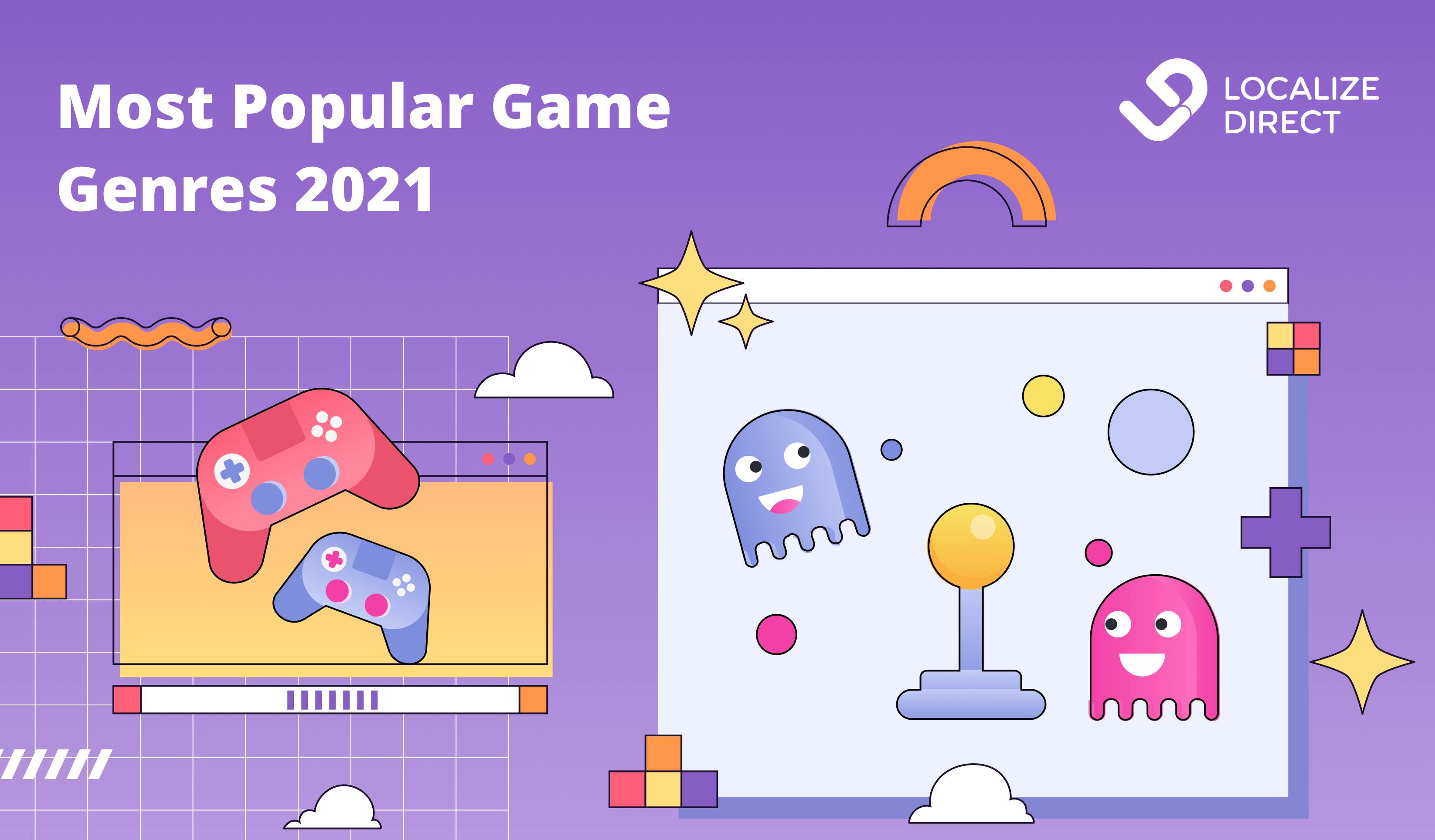
Mobile games are big business. According to Newzoo, in 2021, mobile gaming will be worth $90.7 billion, generating more than half of global gaming revenues ($175.8 billion). Mobile is the fastest-growing games segment (+4.4% YoY). Smartphones became the leading gaming platform, and the mobile gaming market has never been healthier.
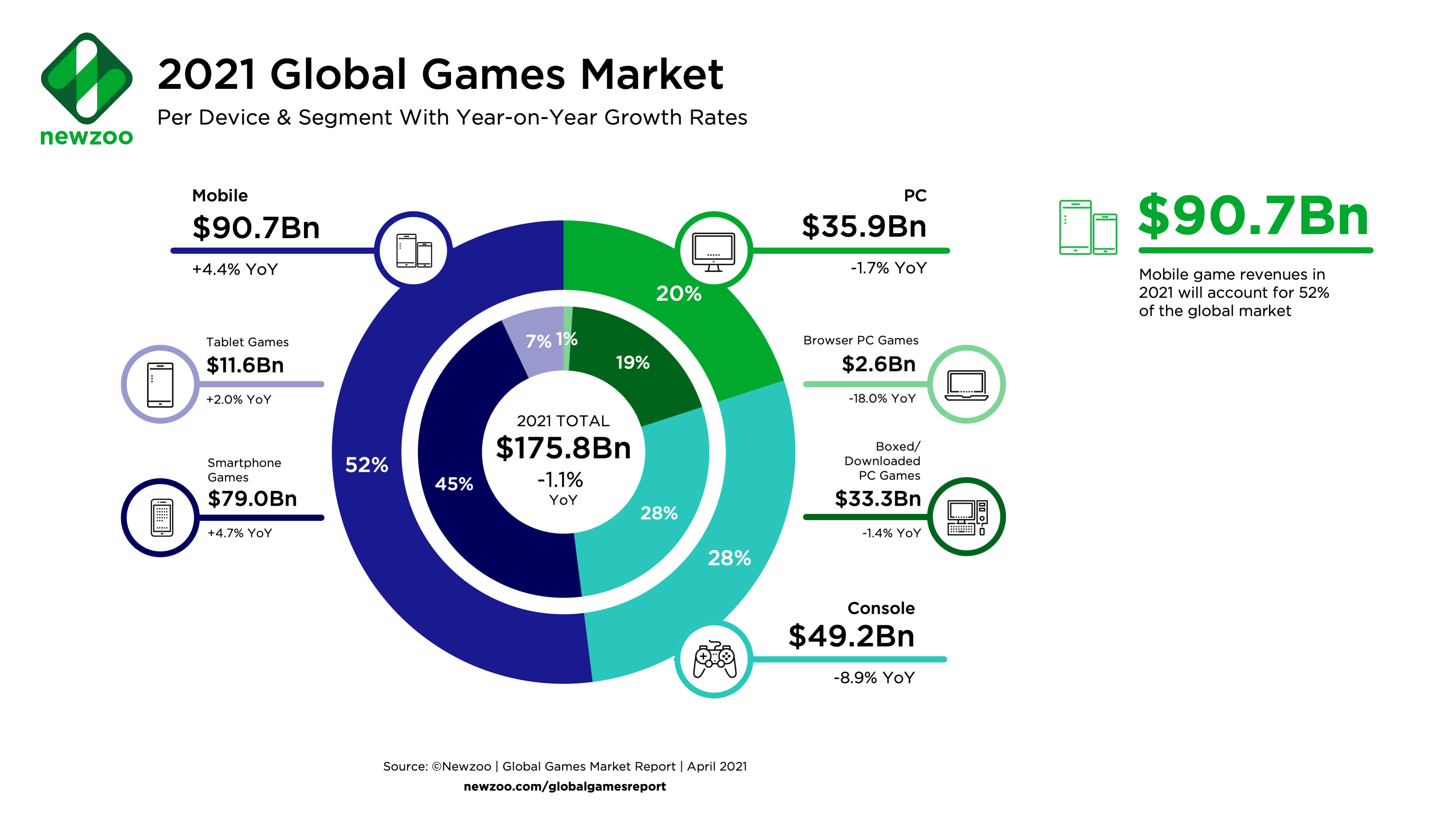
Games have always been the most popular category in the Apple and Google app stores. Whatever way you care to slice it – number of active apps, number of downloads, time spent, revenue generated.
Games represent 10% of the users time spent on apps. On average, there are 8 games installed per mobile device in the US. Globally, the smartphone users play an average of 2 to 5 games per month.
Statista data reveals that games make up nearly 1/4 of all the active apps in the iOS App Store.

The top 5 most popular Apple App Store categories. Source: Statista
How does that share break down into numbers? Over 800,000 games out of 3.3 million apps.
The US, Japan and China demonstrated the highest Y2Y growth rate in terms of the game spend.
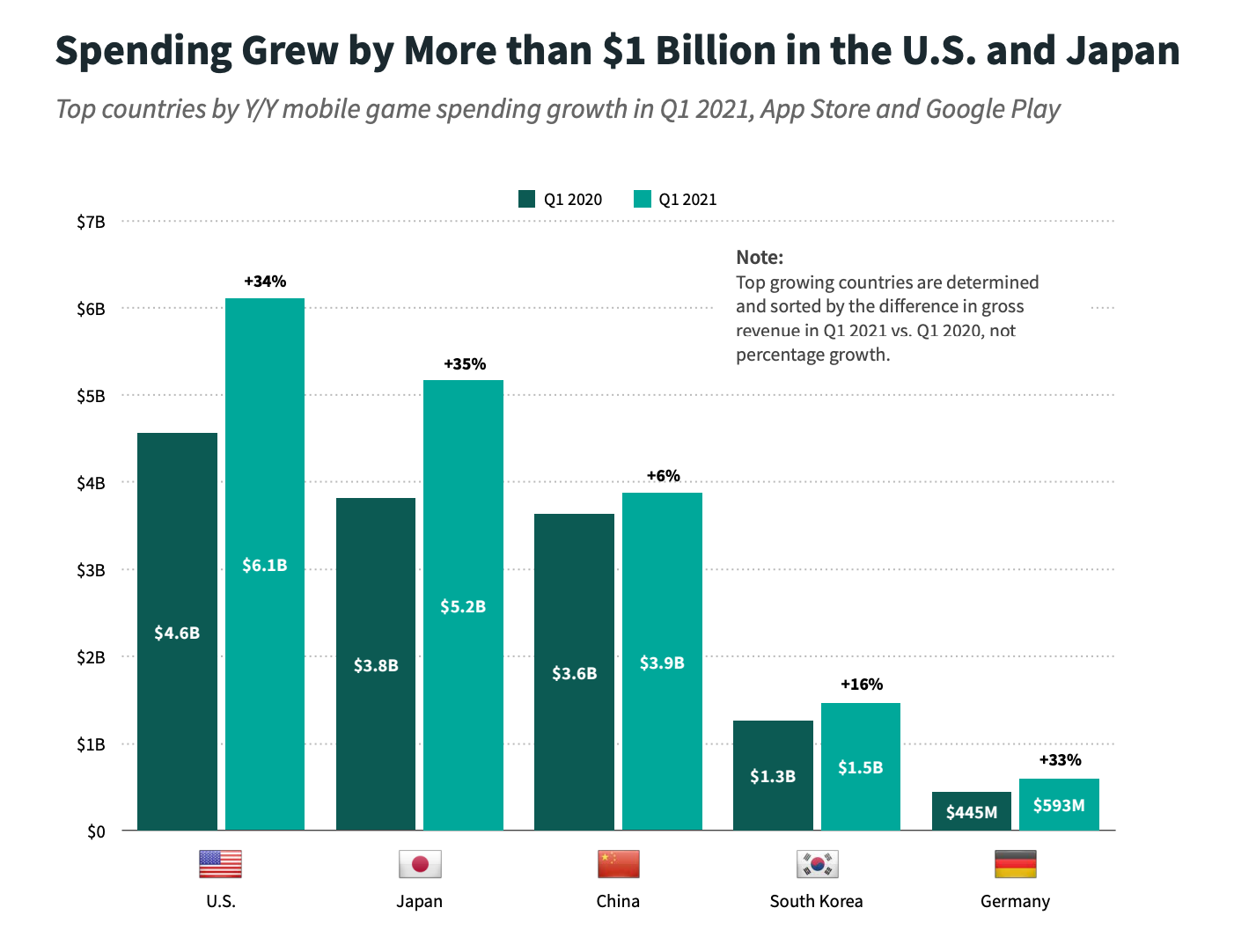
Image source: SensorTower
Note: Worldwide, consumers spent 50% more on iOS than Google Play.
Interesting fact: No longer do games have to be the top 10 or 50 in order to to be successful. In 2019, there were 1121 games that generated over $5M in annual consumer spend. Two years earlier, just 959 games managed to reach such revenue level.
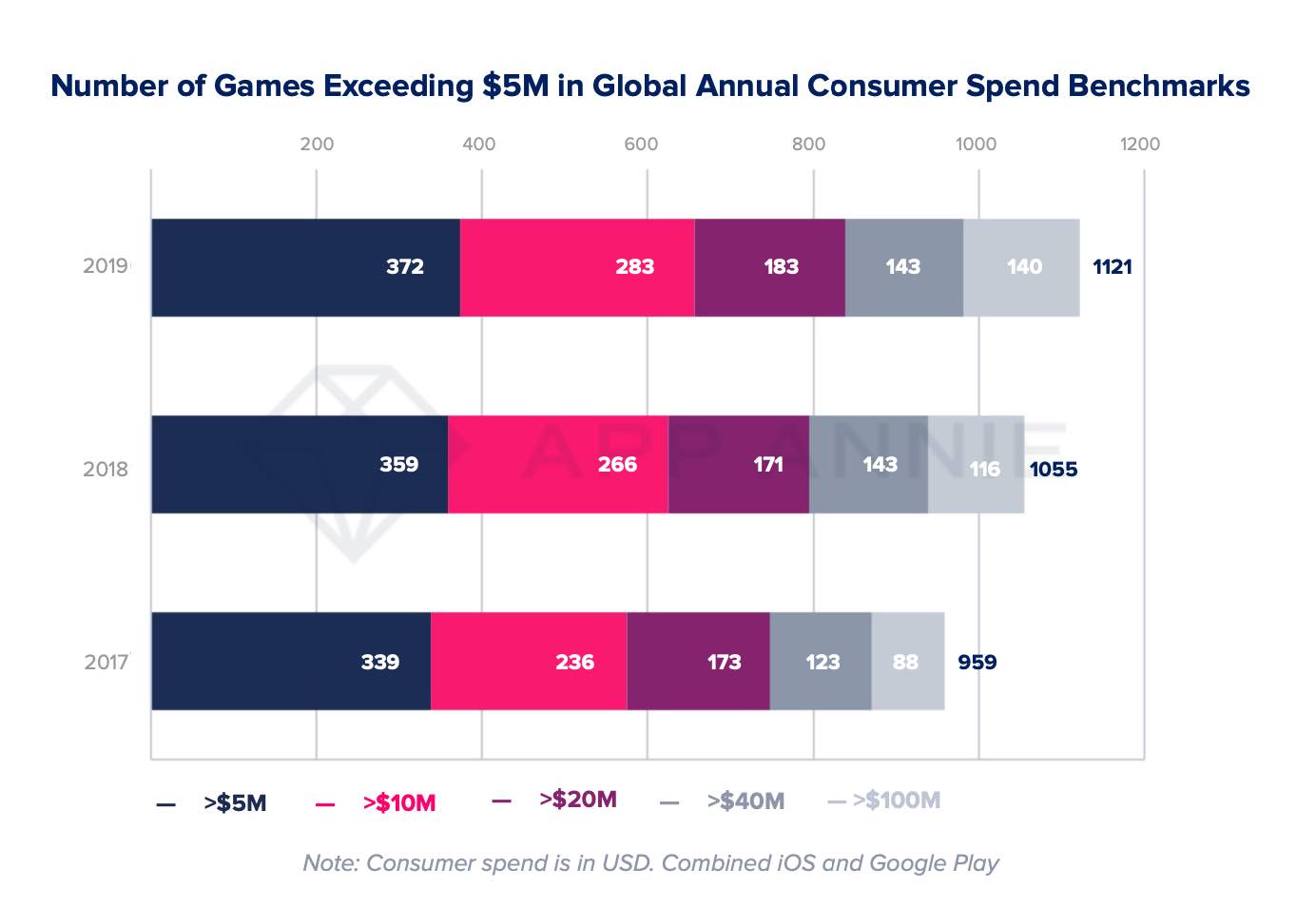
Number of Games Exceeding $5M in Global Annual Consumer Spend Benchmarks. Source: App Annie, 2020.
Women love and play games too: they account for 46% of game enthusiasts who typically play games on mobile, to pass the time.
If we look beyond the total numbers and share we find that games are even more dominant than they first appear.
Before we drill down into mobile game genres and compare their popularity in different languages we should point out their speed of growth.
On average, looking at the last three months of the US App Store statistics, there are more than 3,000 new iOS games released every month.
If we do the same calculation for the total number of apps in 2018, we find between 6,000 and 12,000 new iOS apps released monthly. In April 2020, 1,120 new apps have been published every day.
For Android, there are 2.1 million apps on Google Play. 7.5 billion gaming apps have been downloaded in Q1 of 2019, 35% more than 3 years ago.
In Q2 2020, users downloaded over 14 billion (!) gaming apps from both Google Play and App Store.
Only 13% of iOS games are multilingual. This is a huge missed opportunity for developers. 75% of respondents from ten non-English speaking nations want products in their own language. 55% would only buy at websites where the information was presented in their language, and that figure rose to 80% for those with limited English.
Partial localization is considered better than no localization. A staggering 67% of respondents revealed they would prefer it if at least navigation elements and some content appeared in their language, even if it’s not fully localized.
For mobile games, localizing basic menus, the app description, and other metadata in the app stores could be enough to spark a boost in sales for targeted countries. Localizing the App Store description is the minimum of what you can do for your game or app download rates.
Pro Tip: Check the most promising countries and languages for your game on our free interactive localization map. Alternatively, you can drop and adjust your strings here and get free market volume & revenue prediction. No obligations (and we don’t collect your data at this point).
As StoreMaven observed, “a good first impression increase conversions by 35%”, and half of the installers make their decision solely on the first impression.
What about genres? What are they and how do they differ from country to country? Do the numbers reflect national stereotypes? It’s interesting to examine the top game genres for different markets and languages because there are real variances.
If we take a look at the SuperData research, we may notice that while puzzle games remain a popular category in mobile gaming, the top three grossing titles were MOBA (multiplayer online battle arena) and RPG/MMORPG (massive multiplayer online role playing games).
According to App Annie, in the first half of 2020, hyper-casual games dominated the global mobile market.
Three of the top 5 grossing mobile games featured real-time multiplayer gameplay - from PvP battle, co-op play, to MMORPGs - what proves that this genre can be as popular on smartphones as on PC.
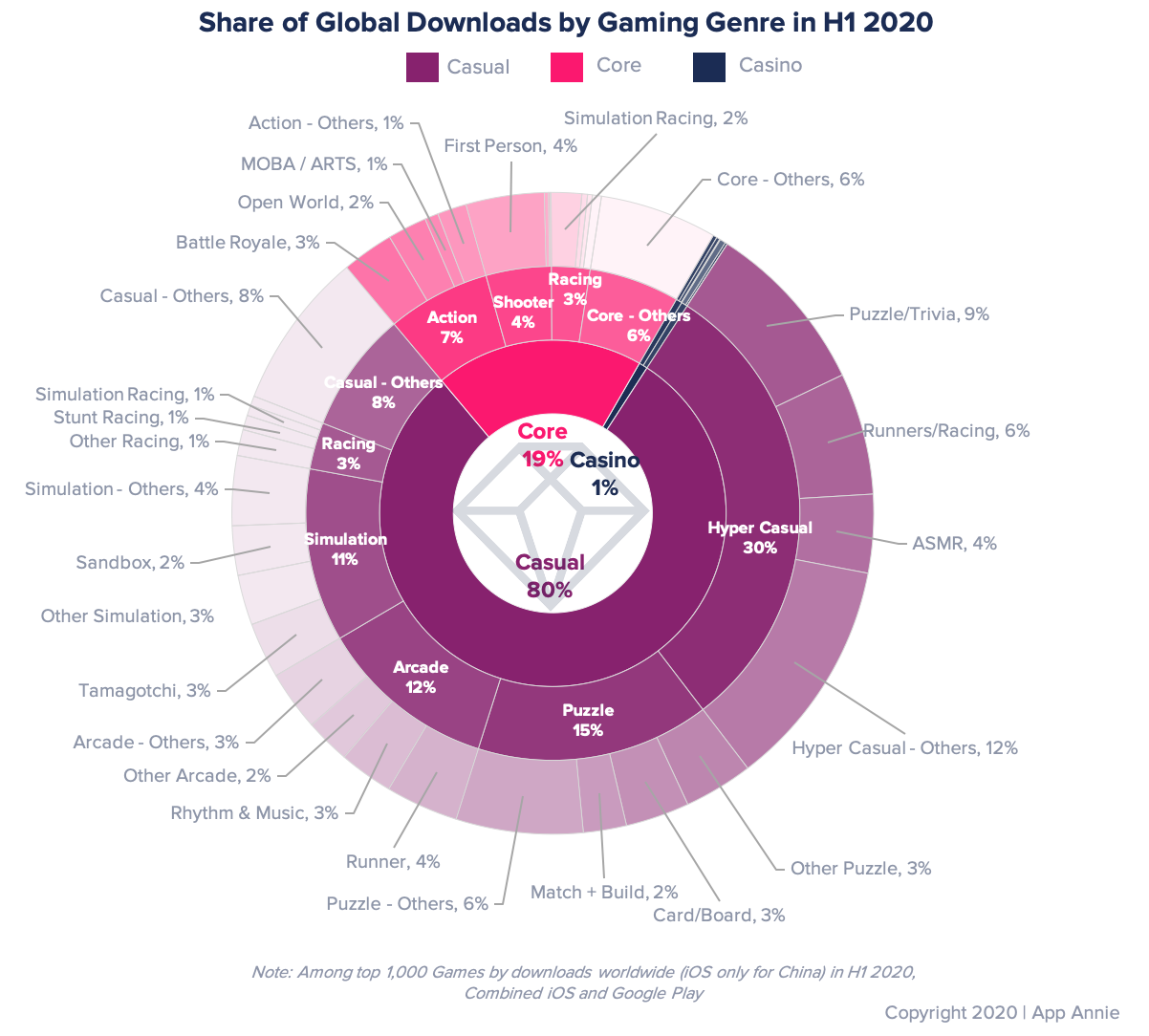
Global mobile downloads by gaming genres. Source: App Annie, 2020.
Would it be safe to assume that certain genres of games are more popular in certain parts of the world? Let’s take a look.
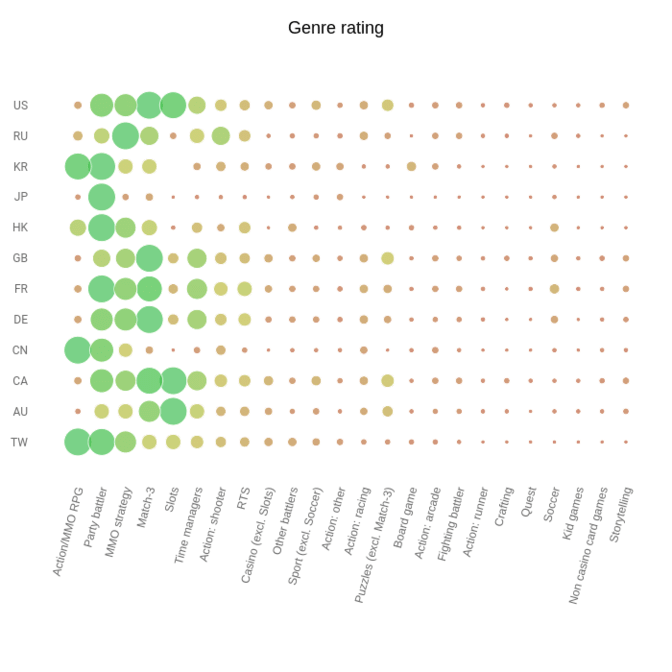
Image source: DataMagic
Market research tool DataMagic revealed the revenue- and downloads-based genre performance scores in the key markets.
In the Western markets, hypercasual, action (arcade), and puzzles (excl. Match-3) were the most downloadable mobile games. This trend was relevant for the Asian markets (South Korea, Japan, China, Taiwan) too, although with some differences.
Unlike the Western users, Asian gamers love playing party battlers and action/MMORPG games, securing them the spots among the top 5 most popular game genres.
However, in terms of the revenue, the match-3, slots, party battlers, and MMO strategy performed best in the West while tamagotchi, adventure, and crafting & building ranked worst.
Japanese gamers were most willing to spend money on the party battlers games. Chinese, Taiwanese and Korean players preferred action/MMORPG to any other game genre. In Russia, MMO strategy games came top in the revenue chart followed by match-3, party battlers and action (shooter).
There aren’t any other major variances that leap out. It’s perhaps surprising just how similar the top game genres are across the board.
It shows broad trends, but it may also be the case that some of the differences are related to the importance of localization for those game genres rather than indicative of the popularity of those genres.
We aren’t taking into account how many English language games are being downloaded and played in non-English speaking countries; a practice that is much more common in Germany, for example, than it is in Korea.
There are certainly some geographical differences in game genre popularity across the globe. The statistics and comparisons make for interesting reading and could help you decide on which countries to target. One thing that isn’t in doubt is that localizing your mobile game increases your potential audience.
See what Steam Spy said…
As with most platforms, genre matters when it comes to scoring a hit on #Steam: Action and simulation games among the most likely to being a hit game, while strategy and racing games are among the least like to being a hit game. #platformcompetition cc @Steam_Spy @SteamDB pic.twitter.com/NDMOAUEpU1
— Joost Rietveld (@gjrietveld) 7 February 2019
Getting ready to localize your game? Learn what to consider before starting a localization project, from setting up your file to creating a style guide.
Some Asian countries are absolute global leaders in the gaming industry: for instance, China, Japan, and South Korea are all in the top 4 by revenue after the US. Other markets (Southeast Asia and the Middle East) are some of the most rapidly growing ones, especially in the sector of mobile gaming.
